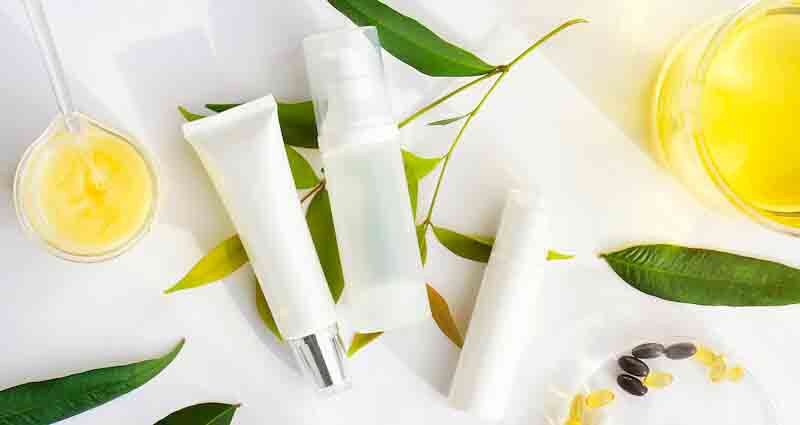Every year, cosmetics companies juggle new terms to promote the youngest magicians in the beauty world. But this, among us, often leads to more confusion than actual joy at women’s new miracle weapons. After all, what are antioxidants, urea, hyaloronic acid and co.? How do they work and what is behind the trend terms such as dermabrasion or anti-frizz? Our guide explains how to understand the cosmetic lexicon to reveal the products and ingredients of cosmetics, so that you can keep track of them next time you visit the drugstore.
The cosmetic lexicon
Allantoin
Cosmetic products with allantoin have a moisturizing, irritant-relieving and regenerating effect. It is particularly suitable for redness, scarring and sensitive skin.
Aloe Vera
Aloe Vera, also known in the cosmetic lexicon as desert lily, is one of the oldest medicinal plants in the world. The gel of the plant is used in many care products due to its moisturizing and soothing effect. Thus, it is particularly suitable for sensitive or impure skin, for care after the sun band or shaving.
Anti-Frizz
Hair products that advertise with “anti-frizz” have additional ingredients. Mostly these are special oils that smooth frizzy and unruly hair.
Antioxidants
Antioxidants are the little helpers of the woman against her supposedgreatest enemy: aging skin. Antioxidants in the cosmetic lexicon fight against the cell-damaging free radicals, which cause the skin to age faster due to UV radiation, smoking and other harmful environmental influences. The most well-known and effective defenders of our skin are vitamin C and E, beta-carotene and trace elements such as zinc and manganese. Avocados in particular score with balast substances and antioxidants and are therefore perfect for the care of mature skin.
Alpha-hydroxy acids
Alpha-hydroxy acids in the cosmetic lexicon are fruit acids that free the skin from small lumps. Due to their peeling effect, they are also often used in small doses in anti-aging care or in impure skin.
Base Coat
This is simply another word in the cosmetic lexicon for undercoat. Even if it means more work, you should not give up a good undercoat to protect your nails from discoloration.
BB-Cream
“Blemish Balm” in the cosmetic lexicon means as much as balm for blemishes. These all-rounders are creams that are supposed to cover all facial products in one tube. Both day or moisturizer, primer and sun protection. Your goal: to make blemish, impurities or redness invisible.
Beta-carotene
Beta-carotene, which is in carrots, tomatoes or spinach, is one of the antioxidants in the cosmetic lexicon and is therefore often used for anti-aging products. It stimulates the production of melanin, which naturally protects against UV irradiation.
Biotin
This vitamin is in egg yolks, fish or walnuts. It strengthens the cell structure of skin, hair and nails. Biotin in the cosmetic lexicon is particularly suitable for brittle nails or damaged hair.
Blush
See Rouge
Camouflage
It’s not just fashion that gets camouflaged. Camouflage in the cosmetic lexicon comes from French and means exactly this: “camouflage”. Camouflage is a very deck-strong and waterproof primer for partial lamination of skin anomalies, shadows or scars.
Ceramides
Ceramides in the cosmetic lexicon are natural fats that are used both as moisturizers in the skin and in hair care. Of course, they occur in the layer of the skin and protect it from moisture loss. In industry, for example, these fats are obtained from yeast.
Collagen/collagen
This structural protein of the connective tissue is known for its low stretchability and thus keeps the same tight. However, with age, the proportion of collagen in the tissue is reduced and the moisture absorption of the skin decreases. This is why collagen is a popular active ingredient for regenerating and moisturizing care products. It is particularly popular in plastic surgery for wrinkle and lip injection. The protein is usually obtained from cattle and is therefore broken down by the organism as an alien substance. Thus, its effect is not permanent.
Concealer
The little ink killer of our beauty bag. With this cover pen, small skin irregularities, eye rings and redness should be covered by plucking into the skin first. Small tip from me: Always choose the concealer a shade brighter than the foundation to achieve an optimal result.
Conditioner
In general, Conditioner is the English word for a care rinse and includes in the hairdressing world various products that are applied like a rinse additionally after washing the hair with shampoo. They are intended to give the hair more shine and better combability.
Dermabrasion
The motto also applies in cosmetics: “Diamonds are a girls best friend”. This method cuts skin bumps, such as pigment spots or scars, with the help of a small diamond cutter. This peeling should only be performed by a dermatologist. Through grinding, open wounds are created, which promote cell renewal. After a two-week sore ness, the skin shines in a new, smooth and supple form.
Foundation
Font de Teint, Foundation or even Primer are all terms for the basis of any make-up. The primer itself is often referred to as make-up, but it is only a fraction (see make-up). Whether tinted cream, liquid, mousse or powder – foundations are available in a variety of designs for different preferences and skin types. Primers in the form of mousse are easy to apply and more opaque than creams or liquid foundations. Powder, on the other hand, mattifies efficiently and can be applied alone or even after primer.
Fruit acid
The fruit acid, or AHA (Alpha-Hydroxy-Acid), is, as its name suggests, extracted from oranges, lemons, apples and the like. The AHA’s gently dissolve old skin flakes and cornea, bright pigment spots visually and ensure that your skin forms new cells faster. Often so-called fruit acid scrubs are used in cosmetic studios. They promise that the skin will then be able to absorb and store moisture better.
Facial tonic
The facial tonic or water should only be applied after cleaning or varnising the face in order to remove residues of make-up. Depending on the skin type, a facial tonic with different alcohol content should be used. In the case of dry skin, alcohol should be avoided in the facial water, as it removes moisture from the skin. In oily skin, on the other hand, this effect is beneficial. Many cosmetic companies also have Skin Freshener in their range. This can be used after the facial water to refresh the skin as the name suggests. Often an astringent effect is also advertised. This pulls the pores together and thus refines the skin.
Highlighter
In the world of beauty and beauty, there is no way around the highlighter. In the form of powders, creams and co., you can use it to set highlights on the skin. Fine pigments act like small mirrors and reflect the invading light. As a result, the skin has a radiant effect and, if placed correctly, the face shape can be accentuated. Applied under the eyebrow, the eye appears larger and at the top of the cheekbone these are visually highlighted.
Hyaluronic acid
An essential ingredient of cosmetics: Hyaluronic acid is responsible for binding moisture in the tissue and thus ensures a flat and firm skin. As we age, however, the ability of our tissues to keep moisture decreases. Hyaluronic acid, similar to collagen, counteracts this effect. Hyaluronic acid is also used in cosmetic surgery to inject wrinkles medically.
Keratin
These proteins strengthen skin, hair and nails. Keratin care products are suitable for damaged or fine hair as well as brittle nails.
Compact powder
Compact powder is used to matte shiny areas and can also be used to fix liquid make-up.
Linefiller
This anti-aging cosmetic product fights small wrinkles. Collagen, small silicone beads or hyaloronic acid fill the tissue structure and thus wrinkles at short notice. This makes the skin appear softer and more even.
Makeup
Incorrectly, make-up is often used as a synonym for primer. It is true, however, that make-up describes the complete, make-up look: from the foundation, the eye make-up and lipstick to blush and mattifying powder.
Mineral make-up
Mineral make-up is a cosmetics based on minerals. The fine nature of foundation, eyeshadow and co. prevents the same from getting stuck in pores and small wrinkles. This makes your make-up look smoother and smoother.
Mist
Mist sprays are sprayed on the skin with the help of atomizers as a fine mist. They leave a light and very subtle scent on the skin and, unlike a perfume, should refresh it and then fly again faster. The perfect solution for those who find traditional perfumes too intense.
Primer
The make-up before the make-up. The primer not only conceals wrinkles and skin irregularities, but also ensures long-lasting make-up and that’s the difference with the concealer. In addition to the primer for the skin, it is also available for the lips and eyeshadow. This keeps the make-up longer and the colors look stronger.
Powder
The powder is a must-have in any handbag. It is widely used in the beauty industry. See Foundation. Because it often has to be fast with make-up, it can happen that it falls to the ground and breaks.
Panthenol
Panthenol is also known as provitamin B5. Due to its moisture-binding and irritating effect, the cosmetics industry uses it primarily in care products for brittle skin, dry hair and lip care pencils.
Parabens
To ensure that foundation, creams etc are longer-lasting and free of bacteria and fungi, chemical preservatives such as parabens are often used in the cosmetics industry. Parabens, however, are suspected of acting similarly to hormones due to their chemical nature in the body, thereby promoting cancer growth.
Peptides
These protein building blocks stimulate natural cell regeneration and are therefore often used in anti-aging products and care lines for sensitive skin.
Q10
The coenzyme is produced by the body itself and can be absorbed through both food and skin. However, with age, in-house production declines. Q10 stimulates cell renewal positively, ensures more elasticity of the skin and can thus minimize wrinkle formation.
Retinol
Retinol is converted into vitamin A in the body and helps women effectively fight pigment spots, with impure skin and combats the breakdown of collagen. As a small side effect, it also strengthens the eyesight.
Rouge
Even the nobles in the time of Louis XVI used rouge (French= red) to set a color accent on the noble pallor of their face. The rouge is applied to the cheeks in red, pink or brown tones to make them look fresher and more youthful.
Top Coat
Top coat is coated on the coloured nail polish to protect it from too fast chipping. Additional advantage: it gives the nails extra shine.
Urea
Even if we may not like to hear it, urea or urea is a natural component of the skin. But don’t worry, urea is made artificially and is therefore completely harmless. The moisture-binding and irritating effect is particularly suitable for care products for dry, cracked and sensitive skin types.
Find more tips in our health and beauty section.




